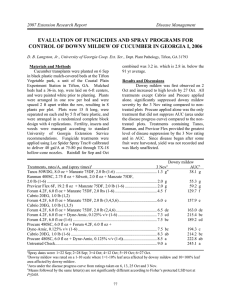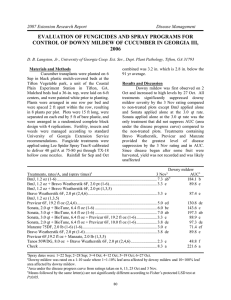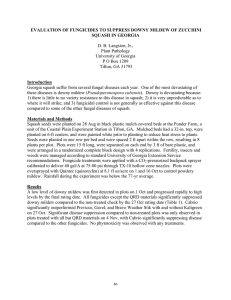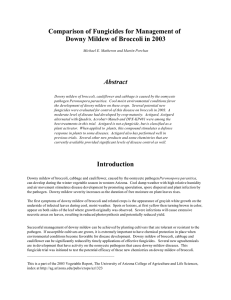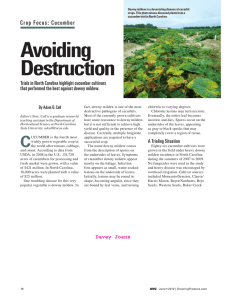dna-markers of sunflower resistance to the downy mildew
advertisement
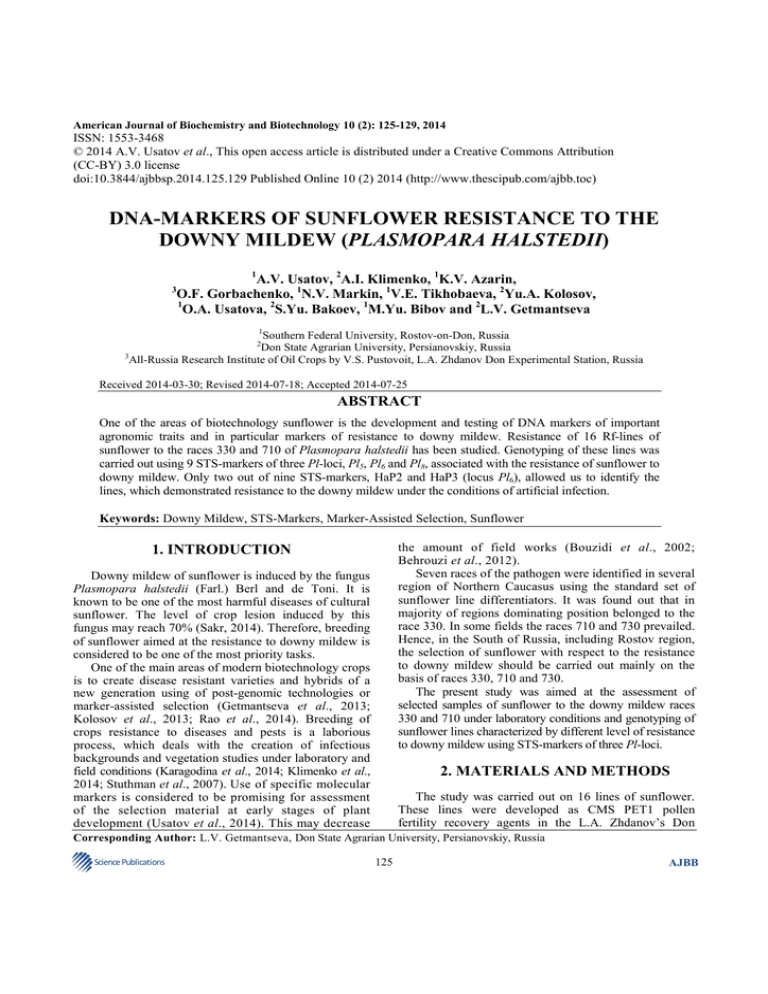
American Journal of Biochemistry and Biotechnology 10 (2): 125-129, 2014 ISSN: 1553-3468 © 2014 A.V. Usatov et al., This open access article is distributed under a Creative Commons Attribution (CC-BY) 3.0 license doi:10.3844/ajbbsp.2014.125.129 Published Online 10 (2) 2014 (http://www.thescipub.com/ajbb.toc) DNA-MARKERS OF SUNFLOWER RESISTANCE TO THE DOWNY MILDEW (PLASMOPARA HALSTEDII) 1 3 A.V. Usatov, 2A.I. Klimenko, 1K.V. Azarin, O.F. Gorbachenko, 1N.V. Markin, 1V.E. Tikhobaeva, 2Yu.A. Kolosov, 1 O.A. Usatova, 2S.Yu. Bakoev, 1M.Yu. Bibov and 2L.V. Getmantseva 1 Southern Federal University, Rostov-on-Don, Russia Don State Agrarian University, Persianovskiy, Russia 3 All-Russia Research Institute of Oil Crops by V.S. Pustovoit, L.A. Zhdanov Don Experimental Station, Russia 2 Received 2014-03-30; Revised 2014-07-18; Accepted 2014-07-25 ABSTRACT One of the areas of biotechnology sunflower is the development and testing of DNA markers of important agronomic traits and in particular markers of resistance to downy mildew. Resistance of 16 Rf-lines of sunflower to the races 330 and 710 of Plasmopara halstedii has been studied. Genotyping of these lines was carried out using 9 STS-markers of three Pl-loci, Pl5, Pl6 and Pl8, associated with the resistance of sunflower to downy mildew. Only two out of nine STS-markers, НаР2 and НаР3 (locus Pl6), allowed us to identify the lines, which demonstrated resistance to the downy mildew under the conditions of artificial infection. Keywords: Downy Mildew, STS-Markers, Marker-Assisted Selection, Sunflower the amount of field works (Bouzidi et al., 2002; Behrouzi et al., 2012). Seven races of the pathogen were identified in several region of Northern Caucasus using the standard set of sunflower line differentiators. It was found out that in majority of regions dominating position belonged to the race 330. In some fields the races 710 and 730 prevailed. Hence, in the South of Russia, including Rostov region, the selection of sunflower with respect to the resistance to downy mildew should be carried out mainly on the basis of races 330, 710 and 730. The present study was aimed at the assessment of selected samples of sunflower to the downy mildew races 330 and 710 under laboratory conditions and genotyping of sunflower lines characterized by different level of resistance to downy mildew using STS-markers of three Pl-loci. 1. INTRODUCTION Downy mildew of sunflower is induced by the fungus Plasmopara halstedii (Farl.) Berl and de Toni. It is known to be one of the most harmful diseases of cultural sunflower. The level of crop lesion induced by this fungus may reach 70% (Sakr, 2014). Therefore, breeding of sunflower aimed at the resistance to downy mildew is considered to be one of the most priority tasks. One of the main areas of modern biotechnology crops is to create disease resistant varieties and hybrids of a new generation using of post-genomic technologies or marker-assisted selection (Getmantseva et al., 2013; Kolosov et al., 2013; Rao et al., 2014). Breeding of crops resistance to diseases and pests is a laborious process, which deals with the creation of infectious backgrounds and vegetation studies under laboratory and field conditions (Karagodina et al., 2014; Klimenko et al., 2014; Stuthman et al., 2007). Use of specific molecular markers is considered to be promising for assessment of the selection material at early stages of plant development (Usatov et al., 2014). This may decrease 2. MATERIALS AND METHODS The study was carried out on 16 lines of sunflower. These lines were developed as CMS PET1 pollen fertility recovery agents in the L.A. Zhdanov’s Don Corresponding Author: L.V. Getmantseva, Don State Agrarian University, Persianovskiy, Russia Science Publications 125 AJBB A.V. Usatov et al. / American Journal of Biochemistry and Biotechnology 10 (2): 125-129, 2014 Experimental Station of oil-Bearing Cultures (Table 2). The criterion of sensitivity at fungus identification was the presence of conidial sporification on cotyledons and true leaves, necrosis and chlorosis; the criterion of resistance was absence of the disease symptoms. Resistance and sensitivity were assessed as the percentage of affected and healthy seedlings. All experiments were carried out in the climate controlling chamber (Binder, Germany) and repeated 3-5 times for 50-00 plants of each line. To perform the molecular genetic analysis, genomic DNA was isolated from leaf tissue as described in (Boom et al., 1990). Primer sequences were taken from articles previously published by other authors in order to identify 9 STS-markers of three Pl-loci (Pl5, Pl6 and Pl8) associated with resistance to downy mildew (Bouzidi et al., 2002; Radwan et al., 2004) (Table 1). Polymerase chain reaction was carried out in 25 µL reaction mixture of the following composition: 67 mM Tris-HCl buffer, pH 8.8, 16 mM (NH4)2SO4, 2.5 mM MgSO4, 0.1 mM mercaptoethanol, 0.25 mM of each dNTP (dATP, dCTP, dTTP and dGTP), 20 pM primers, 2.5 units of Taq-polymerase and 15 ng isolated DNA. Amplification was performed in the thermocycler PalmCycler (Corbett Research, Australia) (Markin et al., 2013). Table 1. The characteristics of primers used for identification of STS-markers of Pl-loci Primer 5’-3’sequence HaP1 F: GGTAATGGCTGTTGAATTTATGGAGC R: GCATGATCCGGCTAGAGCCTTCTA HaP2 F: GTCTACTACATGGTTTCCGTTTTC R: TGCTTCTTCCTTCTATCTCACTC HaP3 F: GTTTGTGGATCATCTCTATGCG R: TGCTTCTTCCTTCTATCTCACTC Ha-P1 F: GCCCAAAATTGAAAGAAAGGTGTG R: GGCGAAATTGGTTCCCGTGAGTCG Ha-P2 F: AATCTTGAGTCATTACCCGAGC R: CAGCGTCTCTGGTAGATCGTTCACC Ha-P3 F: AGTTAACCATGGCTGAAACCGCTG R: TTTGAAAGATAAGTTCGCCTCTCG Ha-P4 F: GCTGTTACTGCCCTCTTCAAAGTC R: CCCAACTCGACATATCTTCAAACC Ha-P5 F: TAGTTAACCATGGCTGAAACCGCTG R: CCCCATATTGACAAAGAGTTGAGG Ha-P6 F: TAGTTAACCATGGCTGAAACCGCTG R: CGTCTCTGGTAGATCGTTCACCTT Locus Pl6 Pl6 Pl6 Pl5,8 Pl5 Pl5,8 Pl8 Pl8 Pl8 Table 2. The sunflower lines tested for sensitivity to the downy mildew races 330 and 710 Percentage of infection with the downy mildew, % ----------------------------------------------------------------------------------------------Line Race 330 Race 710 J-5/3452 000 1000 J-5/2884 100 1000 J-5/2586 000 91,7 J-6/1285 000 0000 J-7/108 100 1000 J-10/256 100 1000 J-7/38 100 1000 J-8/154 000 0000 J-11/385 000 1000 J-11/420 000 0000 J-11/536 000 0000 J-11/112 000 1000 J-7/465 000 0000 J-10/186 100 1000 J-9/508 920 1000 J-9/428 100 1000 Science Publications 126 AJBB A.V. Usatov et al. / American Journal of Biochemistry and Biotechnology 10 (2): 125-129, 2014 dominant genes called Pl-genes, which determine resistance to different races of Pl. halstedii. According to the previously published data, the world population of Pl. halstedii contains about 37 races, 6-7 of which may be considered as dominating ones (Liu et al., 2012). Genes Pl1 and Pl2 were identified in 1970 s and were found to be associated with resistance to races 100 and 300 of downy mildew (Zimmer, 1974). After successful introduction of these genes into the hybrid lines, in the following two decades, new races of this pathogen, which are tolerant to the previously found resistance genes, appeared. Later on, the gene Pl6, which determines resistance to 11 races of downy mildew causative agents, was identified in the wild form of H. annuus. It is presently shown that Pl6 locus contains at least 11 tightly linked genes, each of which provides resistance to one of the races of downy mildew (Bouzidi et al., 2002). Gene Pl8 is the analogue of the gene Pl6 though identified in H. argophyllus rather than in H. annuus. Gene Pl7 was found in H. praecox. Further analysis showed that genes Pl1/Pl2/Pl6 complex belong to the first linkage group and referred as the TIR-NBS-LRR resistance group and genes Pl5/Pl8 complex to the second linkage group and non-TIR-NBS-LRR group. The most recent publications report about the finding of new resistance genes, Pl13 and Pl16, which were identified in the cultural sunflower line HA-R5 and determine resistance to the races 100, 300, 310, 330, 700, 710, 730, 731 and 770 (Liu et al., 2012; Mulpuri et al., 2009). We analyzed known STS-markers of three Pl-loci (Pl5, Pl6 and Pl8) associated with the resistance of sunflower to downy mildew (Fig. 1), because this resistance is known to be controlled by dominant genes. The analysis was carried out on the sunflower lines, which demonstrated different level of resistance to the disease, in order to identify the lines most informative for the marker-assisted selection. These DNA-markers may be useful for fast identification of genotypes potentially resistant to this pathogen within vast samples. We believe that this would provide more effective solution for the problem of sunflower resistance to downy mildew. Only two (НаР2 and НаР3) out of nine STS-markers that mark the Pl6 locus were found to be informative. However, they allowed us to mark 4 out of 5 lines resistant to the downy mildew: J-6/1285, J-8/154, J11/420 and J-7/465. In the genotypes of the resistant lines specific 1200 B.P. (НаР2) and 1800 B.P. (НаР3) PCR-fragments were found that is consistent with previously obtained data (Bouzidi et al., 2002). It is noteworthy that the third of the markers of the Pl6 locus (HaP1), the primers of which flank a 2000 B.P. motive, which includes marker sequences of НаР2 and НаР3, did not provide identification of resistant genotypes. Thermal regime of the reaction was chosen individually for each pair of primers on the basis of their sequences. For majority of reactions the optimal thermal regime was as follows: (1) Denaturation at 95ºC for 3 min, (2) 35 cycles at the following thermal and time regime: Primer annealing at 60°C for 30 s, 2 min elongation at 72°C, denaturation at 95°C, 30 s, (3) 1 min final elongation. For other amplification reactions the regime was as follows: (1) Denaturation at 94°C, 3 min, (2) 33 Cycles at the following thermal and time regime: 94°C, 10 s, 60°C, 30 s and 72°C, 1 min 30 s, (3) final elongation at 72°C, 5 min. Amplification products were analyzed by electrophoresis in 1% agarose gel supplemented with ethidium bromide in Tris-Borate buffer (Kim et al., 2012). The obtained gels were photographed with the gel-documenting system (GelDoc 2000, BioRad, United States). Gene ruler 1 Kb DNA Ladder (Fermentas, Lithuania) was used as a molecular weight marker. 3. RESULTS AND DISCUSSION The assessment of the resistance of 16 parental lines (Rf-lines) to the downy mildew races 330 and 710 was performed in laboratory conditions by the method of artificial infection of sunflower seedlings with spores of Pl. halstedii. 5 out of 16 lines, namely J-6/1285, J-8/154, J11/420, J-11/536 and J-7/465, were found to be resistant to both races (330 and 710) of downy mildew. Conversely, six lines, J-5/2884, J-7/108, J-10/256, J-10/186, J-9/508 and J9/428, were shown to be sensitive to these two races. Other five lines, J-5/3452, J-5/2586, J-7/381, J-11/385 and J11/112, were not affected by the race 330, though was sensitive to the race 710. Hence, our experiments revealed the sunflower lines, which were characterized by different sensitivity to the downy mildew. Resistance to a wide range of pathogens, including viruses, bacteria, fungi, insects and nematodes, is determined by the Resistance genes (R-genes). They contain conservative sequences that determine variety of functions. Presently, at least five classes of R-genes are known. These are intracellular protein kinases, receptorlike protein kinases, which contain Leucine-Rich Repeats (LRR), intracellular LRR-proteins, which contain Nucleotide Binding Site (NBS) and leucine-zipper motive, intracellular NBS-LRR-proteins, which carry Toll and Interleukin-1-Receptor (TIR) homologous domain and LRR-proteins, which provide binding of extracellular proteins to the plasma membrane (Bouzidi et al., 2002). Study of genetic principles of sunflower resistance to the parasite Pl. halstedii allowed identifying of specific Science Publications 127 AJBB A.V. Usatov et al. / American Journal of Biochemistry and Biotechnology 10 (2): 125-129, 2014 (a) (b) Fig. 1. The electrophoregram of amplification products of genomic DNA of sunflower: (A) PCR with the primer НаР2; (B) PCR with the primer НаР3. The results of two PCRs carried out individually for each line are shown. The unique fragments corresponding to the lines resistant to the downy mildew are outlined. Line shows the sample, which demonstrated resistance to the downy mildew in laboratory conditions, but specific PCR fragment was not identified. M-molecular weight marker (1 Kb) Tested STS-markers of the loci Pl5 and Pl8 did not allow us to identify genotypes resistant to the downy mildew, because they were equally present in all the lines studied. It should be noted that in sunflower this disease may be not manifested at the early stages of plant growing (Sakr, 2014; Al-alawi and Obeidat, 2013; El-Shehawi et al., 2013). Moreover, it was shown that visually healthy plants, which were grown among the infected ones, produce seeds that are the carriers of downy mildew (Sakr, 2014; Pishdar et al., 2013). Therefore, plants of the line J-11/536, which demonstrated resistance to the downy mildew at early stages of growing, but were not marked with STS by the resistance loci, should be studied throughout the vegetation period and their seeds should be analyzed as well. resistance of sunflower to the downy mildew. Only two out of nine STS markers (НаР2 and НаР3, locus Pl6) provided successful identification of lines, which demonstrated resistance to the downy mildew in experiments with artificial infection. The studied DNA markers НаР2 and НаР3 may be especially promising for the marker-assisted selection of sunflower with respect to resistance to the downy mildew. 4. CONCLUSION Al-alawi, M. S. and M. Obeidat, 2013. Selection of beauveria bassiana (balsamo) vuillemin isolates for management of Myzus persicae (sultzar) (HOM: Aphidae) based on virulence and growth related characteristics. Am. J. Agric. Biol. Sci., 9: 94-100. DOI: 10.3844/ajabssp.2014.94.100 Behrouzi, F.G., S. Germchi and M. Yarnia, 2012. Effect of complete micro nutrient fertilizer application on soybean yield and yield components. Am. J. Agric. Biol. Sci., 7: 412-416. DOI: 10.3844/ajabssp.2012.412.416 5. ACKNOWLEDGEMENT This research was supported by the Russian Ministry of Education and Science, project no. 40.91.2014/K. 6. REFERENCES Resistance of Rf-lines of sunflower cultivated in the L.A. Zhdanov Don Experimental Station of Oil-Bearing Cultures to the most widely spread in Rostov region races of the downy mildew 330 and 710 was assessed. Lines contrastingly different by the resistance to these two races of the downy mildew were identified in laboratory conditions by the method of artificial infection. They were also genotyped with 9 STS-markers of three Pl-loci (Pl5, Pl6 and Pl8) associated with Science Publications 128 AJBB A.V. Usatov et al. / American Journal of Biochemistry and Biotechnology 10 (2): 125-129, 2014 Boom, R., C.J. Sol, M.M. Salimans, C.L. Jansen, P.M. Wertheim-van Dillen et al., 1990. Rapid and simple method for purification of nucleic acids. J. Clin. Microbiol., 28: 495-503. DOI: 00951137/90/030495-09$02.00/0 Bouzidi, M.F., S. Badaoui, F. Cambon, F. Vear and D.D. Labrouhe et al., 2002. Molecular analysis of a major locus for resistance to downy mildew in sunflower with specific PCR-based markers. Theor. Applied. Genet, 104: 592-600. DOI: 10.1007/s00122-0010790-3 El-Shehawi, A.M., A.I. Fahmi, M.M. Elseehy and H.A. Nagaty, 2013. Enhancement of nutritional quality of wheat (triticum aestivum) by metabolic engineering of isoflavone pathway. Am. J. Biochem. Biotechnol., 9: 404-414. DOI: 10.3844/ajbbsp.2013.404.414 Getmantseva, L.V., N.V. Mikhailov, A.Y. Kolosov and A.V. Radyuk, 2013. Polymorphism of the Gene MUC4 and reproductive traits in pigs. Izvestiya Nizhnevolzhskogo agrouniversitetskogo kompleksa: Nauka I vy’sshee professional’noe obrazovanie, 3: 143-146. Karagodina, N., Y. Kolosov, A. Usatov, S. Bakoev and A. Kolosov et al., 2014. Influence of various biostimulants on the biochemical and hematological parameters in porcine blood plasma. World Applied Sci. J., 30: 723-726. DOI: 10.5829/idosi.wasj.2014.30.06.82198 Klimenko, A., A. Usatov, L. Getmantseva, Y. Kolosov and O. Tretyakova et al., 2014. Effect of melanocortin-4 receptor gene on growth and meat traits in pigs raised in Russia. Am. J. Agric. Biol. Sci., 9: 232237. DOI: 10.3844/ajabssp.2014.232.237 Kolosov, Y., L. Getmantseva and N. Shirockova, 2013. Sheep breeding resources in Rostov region Russia. World Applied Sci. J., 23: 1322-1324. DOI: 10.5829/idosi.wasj.2014.30.06.82198 Kim, H.A., S.Y. Kwon, H.S. Yoo, M.S. Yang and P.S. Choi, 2012. Development of transgenic maize using immature embryos of HiII genotype as a vaccine candidate. Am. J. Biochem. Biotech., 8: 21-25. DOI: 10.3844/ajbbsp.2012.21.24 Liu, Z., T.J. Gulya, G.J. Seiler, B.A. Vick and C-C. Jan, 2012. Molecular mapping of the Pl16 downy mildew resistance gene from HA-R4 to facilitate marker-assisted selection in sunflower. Theor. Applied Genet., 125: 121-131. DOI: 10.1007/s00122-012-1820-z Science Publications Markin, N.V., T.V. Usatenko, A.V. Usatov, V.E. Tikhobaeva and O.F. Gorbachenko et al., 2013. Informativ DNA markers of gen Rf 1-pollen fertility restorer CMS PET 1 in sunflower. Modern Problems Sci. Edu., 4: 1-7. Mulpuri, S., Z. Liu, J. Feng, T.J. Gulya and C.C. Jan et al., 2009. Inheritance and molecular mapping of a downy mildew resistance gene, Pl13 in cultivated sunflower (Helianthus annuus L.). Theor. Applied. Genet., 119: 795-803. DOI: 10.1007/s00122-0091089-z Pishdar, M., M.R.S. Hashemi Toloun, S. Zamani and F. Farzianpour, 2013. Development of factors effective in the success of green supply chain management. Am. J. Agric. Biol. Sci., 9: 33-43. DOI: 10.3844/ajabssp.2014.33.43 Radwan, O., M. F. Bouzidi, P. Nicolas and S. Mouzeyar, 2004. Development of PCR markers for the Pl5/Pl8 locus for resistance to Plasmopara halstedii in sunflower, Helianthus annuus L. from complete CCNBS-LRR sequences. Theor. Applied Genet., 109: 176-185. DOI: 10.1007/s00122-004-1613-0 Rao,Y., Y. Li and Q. Qian, 2014. Recent progress on molecular breeding of rice in china. Plant Cell Rep., 33: 551-564. DOI: 10.1007/s00299-013-1551-x Sakr, N., 2014. Evolution of new Plasmopara halstedii races under the selection pressure with resistant sunflower plants: A review. Hellenic Plant Protec. J., 7: 1-13. Stuthman, D.D., K.J. Leonard and J. Miller-Garvin, 2007. Breeding crops for durable resistance to disease. Advances Agronomy, 95: 319-367. DOI: 10.1016/S0065-2113(07)95004-X Usatov, A.V., A.I. Klimenko, K.V. Azarin, O.F. Gorbachenko and N.V. Markin et al., 2014. The relationship between heterosis and genetic distances based on SSR markers in helianthus annuus. Am. J. Agric. Biol. Sci., 9: 270-276. DOI: 10.3844/ajabssp.2014.270.276 Zimmer, D.E., 1974. Physiological specialization between races of Plasmopara halstedii in America and Europe. Phytopathology, 64: 1465-1467. DOI: 10.1094/Phyto-64-1465 129 AJBB
